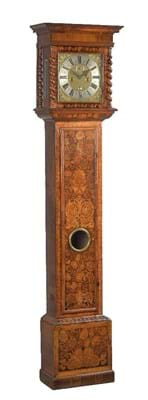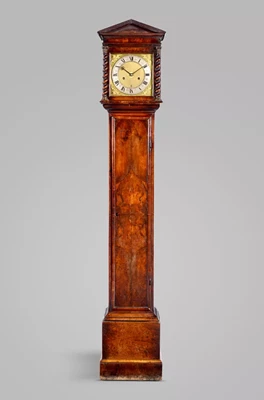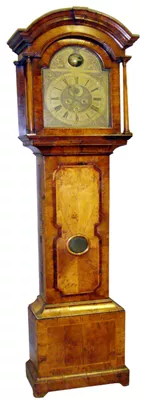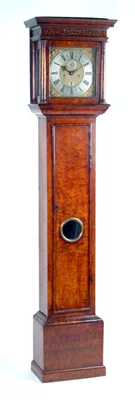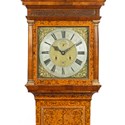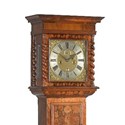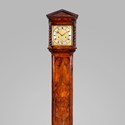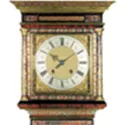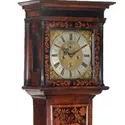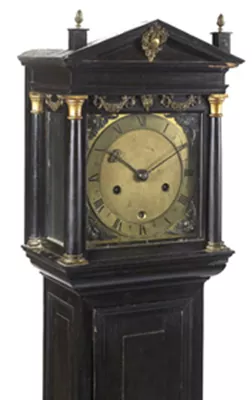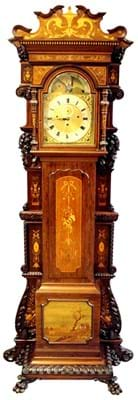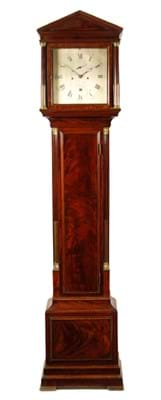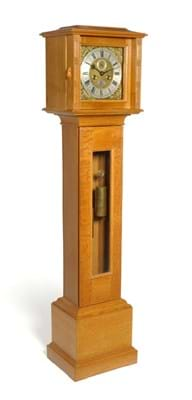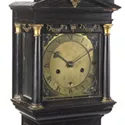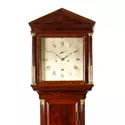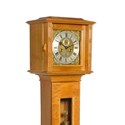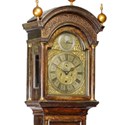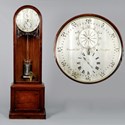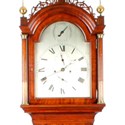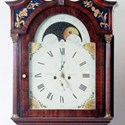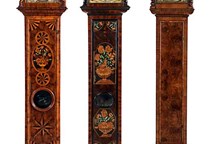First used in clockmaking by the Dutchman Christiaan Huygens in 1656, the pendulum made for near frictionless time-keeping, while it was the anchor mechanism (probably invented around the same time by British scientist Robert Hooke) reduced the swing and improved accuracy.
The need to protect the movement within a high case to house the heavy drive weights, and soon afterwards a long pendulum that beat once every second, led to a style of clock that remained popular for more than two centuries.
What Do People Collect?
The story of the freestanding, weight-driven pendulum clock or longcase is told through a succession of technological breakthroughs designed to make the clocks more accurate, more elaborate in their function or easier to maintain.
Often it is these technical sophistications, many of them pioneered, improved or perfected by the great names in British clockmaking, which interest serious collectors as much as the splendour of the case.
Early rarities from the 'Golden Age' of English clockmaking in the late 17th century are the preserve of the wealthiest collectors. Clocks within the price range of the ordinary collector are likely to conform to relatively standard forms which became established, with regional and other variations, in the 18th and 19th century.
One important distinction is the duration of the movement.
Longcase clocks were traditionally made with two types of movement - eight-day and 30-hour. A small number of clocks with deluxe long-duration movements were able to run for a month or more without recourse to winding.
Typical 17th-19th century eight-day movements run on two weights suspended on a cable and pulley - one driving the hands and the other the striking mechanism - and require two keyholes for winding. Thirty-hour clocks, generally less expensive when made (although in the 18th century still costing the equivalent of two years of a farm labourer's wages), were driven by a single weight.
These are generally wound by pulling down on the weight-pulley cord inside the case.
Whatever lies beneath the hood, the most immediate difference between one longcase and another is seen in the design of the case or the treatment of the face. These range from the simplest estate-made pine case and painted tin dial, to Boulle marquetry and silvered brass. But both will typically reflect the fashions of the time and provide a clue to date.
Case styles will also differ by region. On a national scale this can be seen in the differences between circular dial clocks made in early 19th century Scotland, the potbellied Comtoise clocks from the Franche-Comté region of France and the white-painted Bornholm and Mora clocks from Scandinavia.
On a local scale there are distinct characteristics observed in clocks made in different clockmaking centres of England. These can be as simple as the use of indigenous timbers rather than expensive tropical imports, but the characteristics of the case, the dial and the movement differ from region to region.
As the market for provincially-made clocks has grown (naturally many people wish to own a clock from their locality) specialist publications have been written on a range of British clockmaking centres. These are typically accompanied by information regarding otherwise obscure local clockmakers - from detailed analysis of surviving examples of their work to the simplest of genealogical data.
The Market
The clock market is multi-faceted and the price range is huge.
The top end is typically occupied by so-called Golden Age clocks by celebrated makers from the late 17th and the first half of the 18th century. These venerable timepieces, housed in elegant cases of ebony, walnut, mulberry, marquetry or japanned lacquer, have a long collecting history and appeal beyond the relatively small field of horology.
Pricing depends heavily on quality, condition, movement and maker. Good clocks by eminent names such as Ahasuerus Fromanteel, Thomas Tompion, George Graham, the Knibb family, Joseph Windmills and John Ellicott will bring five- and six-figure sums on the occasions they come to the market. But, across a typical year, only a small handful is likely to be available.
More plentiful are the late 17th and early 18th 'furnishing' clocks by lesser names that - if some imperfections and restoration are tolerated - sell in the £8000-20,000 bracket.
A connoisseur market also exists for those clocks designed for precision timekeeping. The literature is dominated by technical terminology that, although confusing to the uninitiated, is of paramount importance to value.
Harrison's maintaining power, the deadbeat escapement and developments in the field of temperature compensation were all innovations of the 18th century - the period that saw the birth of the regulator clock.
These precision timekeepers, often with outwardly simple dials and cases but very substantial six-pillar movements and heavy grid-iron pendulums, have seen some substantial price movements in recent times. Examples by leading makers such as John Arnold, Edward John Dent, Benjamin Vulliamy and Charles Frodsham are commanding record sums.
Technical sophistication on any level adds value to a clock. These range from a simple calendar aperture or a strike/silent options (for an uninterrupted night's sleep) to rocking ship automatons and rolling lunar cycle (knowledge of the phase of the moon was of great importance when planning a journey during the hours of darkness) to annual calendar dials and the times of sunrise, high and low tides.
Most longcase clocks strike the time on each hour or fraction of an hour, but musical movements were a further sophistication and, by the Edwardian era, many longcase clocks, often with monumental revivalist case styles, housed triple weight-driven movements capable of quarter-striking with the Westminster, Whittington or St Michaels's chimes.
These high quality clocks, capable of high four- and sometimes five-figure sums a decade ago, are sometimes hampered by size but remain popular with the export market.
The price trends for unexceptional or 'furnishing' Georgian or Victorian longcases closely follow the curve set by furniture of the same period. At the present time the market is very soft.
Out of fashion and sometimes simply too large for the modern home, the many clocks currently selling at auction for under £1000 appear excellent value for money. It is certainly a fraction of the original cost in real terms.
Nevertheless, an important feature of the market over the last 25 years has been the growing interest in regional clockmaking, admired for the genius and idiosyncrasies of individual makers (many of them a match for their London contemporaries) and their sense of place. In contrast to the precision timekeepers made at great cost for an elite clientele, many unsophisticated provincial clocks, made for people of more modest means, appeal in much the same way as vernacular furniture and folk art. A bonus can be their relative small size.
Now that their role as timekeepers no longer of paramount importance, this has occasioned some very substantial prices for 30-hour clocks, once a poor relation of an eight-day clock. Equally, the traditional view that a brass dial clock is more valuable than a painted or white-dial clock has been eroded. White dials (popular c.1770-1870) have grown in popularity and are no longer disregarded as they might have been 40 or 50 years ago.
At all levels of the market, from a Golden Age clock to the humble North Country oak-cased clock, condition is key. That a much-valued practical time-keeper will have received some attention in its life is only to be expected, but collectors will quickly distinguish between honest upkeep and excessive restoration, 'improvements' and 'marriages' that comprise a case and movement that did not start out life together. Equally, colour and patina are as important for clocks as they are for antique furniture.
In short, there is a large financial gulf between the few clocks that have survived in original condition and those that have been significantly altered or updated.
Further Reading
The Longcase Clock by Tom Robinson, Antique Collectors' Club, ISBN-10: 0907462073.
Painted Dial Clocks by Brian Loomes, Antique Collectors' Club, ISBN-10: 185149183X.
Clockmakers of Northern England by Brian Loomes, Mayfield Books, ISBN-10: 0952327058.



